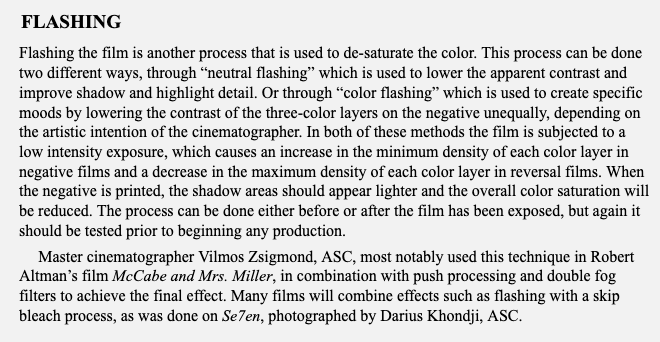-
Posts
26 -
Joined
-
Last visited
Profile Information
-
Occupation
Other
-
Location
India, New York
-
My Gear
Canon EOS 5D Mark II DSLR Camera
-
I am reading a movie analysis on the film Notorious. In that, I came across this passage: "...the “master” is used as a bookend — opening and closing the scene — which is “magnified” (a term coined by Steffan Sharff in The Elements of Cinema) by the two shots that render Devlin and Prescott in separation." I don't clearly understand what the author means by "magnified"? Can someone please clarify this? (2-shot when magnified becomes a single shot?)
-
I was reading a book "Film Production Technique", and it said "Cinematographers will “light for black”...they will light a dark area to just outside of the latitude of the film so that they get a richer black." I didn't quite understand what "lighting for black" means to get the richer black. Let's say the film stock latitude is 3 stops. If I light the black objects but make them fall outside the latitude of the film, it's still not going to give me any details. Then 1) Why do I have to light them? 2) How will I get a richer black when I light them? Thanks.
-
Hello Mr. Mastrion: Thank you for your reply. I looked into the link you gave me. It says how to do the setup in the camera, but I am looking for the meaning of multi-gamma. PS: Please forgive me if this is a basic question. I am a beginner, and I am just learning about the camera and the cinematography concepts.
-
I was reading about Panasonic Varicam Camera. In that, it specified “master-quality, full-resolution 10-bit 4:2:2 AVC-Intra 100 recording; variable frame rates in one-frame increments; HD-SDI output of 23.98PsF/24PsF; and a multi-gamma function including Film-Rec for the prized VariCam look closely matching the color and response of film stocks". What is multi-gamma function in the layman term? (Google search mostly talks about Gamma camera, I believe that is different from this).
-
Thank you for the explanation.
-
Currently, I am reading the book "Cinematography for Directors" by Jacqueline B. Frost. In the chapter "The Lab, the DI, and Achieving "the Look," on Page 221, the author talks about "Flashing." In that, she says, " In both [Neutral flashing and Color Flashing] of these methods the film is subjected to a low intensity exposure, which causes an increase in the minimum density of each color layer in negative films and a decrease in the maximum density of each color layer in reversal films." I never worked on the film, so it's tough for me to understand what the author says here. I understood flashing is done to bring out details in shadows (darker areas) without altering the highlights significantly. But I don’t understand what the author means by "an increase in the minimum density of each color layer in negative films and a decrease in the maximum density of each color layer in reversal films?" Can someone please say what that means? Please see the attached screenshot for author's quotes. Thanks.
-
I was reading some filmmaker quotes (https://scriptcat.wordpress.com/quote-for-today/) and I came across this one. “It’s all about making sure the film bounces off that sheet and comes to life in the mind of the audience. What is a film outside the audience’s mind?” —director George Stevens, Conversations with The Great Moviemakers of Hollywood’s Golden Age at the American Film Institute. I don't understand what Mr. Stevens mean by "film bounces off that sheet and comes to life in the mind of the audience." Can someone please say what he means by that? Thanks.
-
Thank you.
-
I know foreshortening is frequently used in drawings and photography to convey the illusion of three-dimensional space. Do DP/Director intentionally uses this technique in films? Or films have many other techniques (size difference, overlapping, focus, movement etc.) to create the illusion of three-dimensional space that they don't consider foreshortening? Thanks.
-
Hi: I shot my first short film in 16mm in 2011. I bought 7 rolls (Kodak) and used only 6. I kept the remaining one in the fridge (not in the freezer). After that I shot my short films in Digital. Now I am planning to shoot in film again. Can I use the one that is in the fridge? When I bought the film roll, I was told that I can use it within 7 years if it is kept in the fridge. Now I am seeing in some forums that it is not advisable to use it if it is more than 6 months. What is the general time frame? Thanks.
-
In the book 'Film directing fundamentals' by Nicholas Proferes, he mentions as 33 degree rule (Page 174). In other books, it normally says as 30 degree rule. I know three degree doesn't make a difference, but I would like to know why he specify like that? Thanks.
-

Notes on the Cinematographer - Robert Bresson ($ 250)
Prasad Kumar replied to Prasad Kumar's topic in General Discussion
I don't read or speak French. Yes, please send me a message if you find it in the English version. Thank you. -

Notes on the Cinematographer - Robert Bresson ($ 250)
Prasad Kumar replied to Prasad Kumar's topic in General Discussion
I just now called AMPAS Margaret Herrick Library. They said they have many film archive books but I cannot check out the book though. Maybe sit and read and take notes. I applied for the inter library loan. I am on the 7th waiting list. Normally one person can keep the book for 4 weeks. So it may take at least 6 months. I read the snippets of the book and they are real treasures. If getting this book is this difficult in Los Angeles, I cannot imagine the other parts of the world. -
One of the veteran DP recommended me this book 'Notes on the Cinematographer' by Robert Bresson. I looked in amazon and looks like only rich people could afford it. (http://www.amazon.com/dp/1557133654/...=IJ7UFM0VJWOFN) Ebay: http://product.half.ebay.com/Notes-on-the-Cinematographer-by-Robert-Bresson-1987-Book-Other/2879858&tg=info Publisher Green Integer is out of business now, so the books are out of print. That is why the book price is close to $ 200. As a student, I cannot afford this. I checked at my school and they didn't have it. I also checked three Los Angeles public libraries and they didn't have it. Does anyone know where I can buy this book at a reasonable price? Used copy is totally fine. I got snippets in the websites here and there but I prefer a book. Any suggestions? Thanks.



